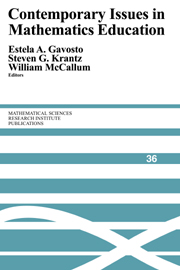Book contents
Instructional Materials for K-8 Mathematics Classrooms: The California Adoption, 1997
Published online by Cambridge University Press: 27 June 2025
Summary
Does 30 divide the product 36 x 45? If you believe it does then you should be concerned. The California State Board of Education does not appear to. In fact, they explained their reasoning in a public document and used it as justification to reject instructional materials for California students.
The year 1997 was an intense one for the California K-12 mathematics education community, with three major events. Each involved controversy, and each involved university research mathematicians. Drawing by far the most media attention — see, for example, [Co] or [La]—was the development and adoption of California's first Mathematics Standards (and Language Arts Standards). During this same period a second group met to prepare a first draft of a new “Mathematics Framework for K-12”, a process which is conducted every seven years and is not yet complete. (A Curriculum Commission version will go to the State Board during 1999.) Finally, between February and September, a follow-up adoption of K-8 mathematics materials was conducted (the primary adoption occurred in 1994). The controversy surrounding this selection is the subject of the present article. The author was a member of both the 1994 and 1997 adoption panels.
California's selection of K-8 instructional materials is especially significant for a number of reasons. Unlike text selections for grades 9-12, where there is a long tradition of teacher autonomy, no state-wide timetable, and which in practice are usually made by individual schools, the K-8 selection determines the materials that most K-8 teachers use and greatly influences what is taught in schools. Further, it provides an important resource for understanding what the State Board values most in educational practice.
Information
- Type
- Chapter
- Information
- Contemporary Issues in Mathematics Education , pp. 109 - 122Publisher: Cambridge University PressPrint publication year: 1999
